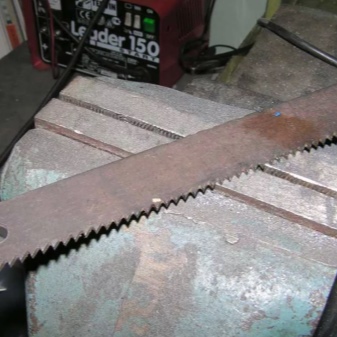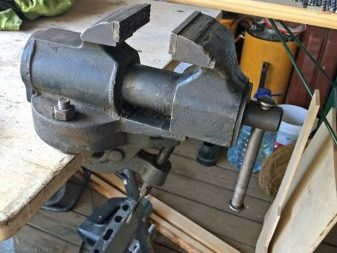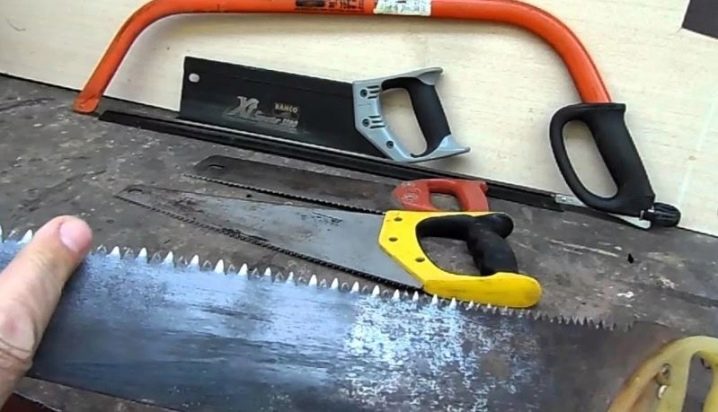How to sharpen a hacksaw at home?

Wood is a unique natural material that is widely used in various spheres of the national economy. It is easy to handle and environmentally friendly. For processing, a hacksaw for wood is very often used - an easy-to-use tool that does not require special skills. Today, electric saws, jigsaws and other power tools are more widely used than hacksaws for wood.

Nevertheless, traditional hacksaws are found in all workshops, in every household, as they are used for quick sawing without much preparation. They are used to saw not only wood, but also used in the processing of chipboard, plastic, various types of flooring and so on. If you need to do work that does not require the connection of powerful equipment, or if the access of the power tool to the object is difficult, there is no alternative to a hand saw-hacksaw. Of course, in order to achieve high results, any saw needs to be sharpened on time.




Why and when do you need to sharpen?
Qualified professionals are aware of the following signs, indicative of the imminent failure of the saw:
- when sawing wood, the hacksaw starts to sound different;
- visually it becomes noticeable that the tips of the teeth are rounded, have lost their sharpness;
- the color of the teeth changes;
- sawing force increases;
- the direction of the saw is poorly maintained;
- there are frequent jamming of the teeth in the wood.


Breeding the teeth must always precede the sharpening process. When breeding, a deviation of the teeth from the plane of the hacksaw to the left and right at a certain angle must be achieved. Too small a tooth deflection angle will cause the teeth to “plant” in the tree. Conversely, a too large angle of deflection of the teeth makes the cut too wide, increases the amount of waste (sawdust) and requires too much muscle energy to pull the hacksaw. The purpose of sharpening teeth is to restore the following tooth geometry:
- step;
- height;
- profile angle;
- bevel angle of cutting edges.


Important! Hardened teeth cannot be sharpened. They are black with a bluish tint.
Saw set
When setting the saw, one should not forget about the uniform bending of all teeth at the same angle, so that there is no increase in drag resistance and high metal wear. It is necessary to start bending the teeth from the middle. If you try to bend them at the very base, you can damage the blade. The teeth deviate from the blade through one, that is, every even tooth to the left, every odd tooth to the right. Visually and without the use of tools, only an experienced carpenter can determine the layout. Such skills come only after breeding the teeth of dozens of hacksaws.


In the absence of such experience, a special tool comes to the rescue. The most affordable option is a regular flat steel plate. A slot is made in it, into which the hacksaw blade should enter with practically no gap. The routing process is as follows:
- the hacksaw is clamped so that the teeth are slightly visible above the clamp;
- each prong is clamped with a wiring groove and bent to the middle;
- the angle of dilution must be constantly monitored;
- each even tooth in a row is bent to the left, then each odd tooth is bent to the right or in reverse order.


With different heights of the teeth, cutting wood will not be effective, since the teeth of a higher height will wear more due to the greater load, and teeth of a lower height will not take part in the work at all. The web broaches will be uneven, twitchy. There will also be complaints about the accuracy of sawing and the quality of the cut surfaces. It is necessary to align the teeth in height before sharpening. The height is checked as follows:
- the prongs are pressed against the paper that lies on a flat surface;
- the canvas is imprinted on it;
- the height of the teeth is determined by the profile of the impression.


To align the teeth with the difference in height, the blade must be clamped in a locksmith's vice and the excess metal removed. If the teeth have a large difference in height, it is necessary to choose an average value and try to trim the maximum possible number of teeth to it.
How to sharpen a hacksaw?
To make sharpening with minimal loss of time and quality, you need to use such special devices and tools as:
- Workbench;
- locksmith vice;
- pliers;
- sharpening bar;
- sandpaper;
- protractor and caliper;
- hammer;
- it is possible to use equipment that allows you to fix the hacksaw blade with an angle of 90 or 45 degrees.


Be sure to use the following files:
- with a triangular section;
- with a rhombic section;
- flat;
- set of needle files.




When sharpening a hacksaw on wood, a simple vice is also used, which is quite uncomfortable and long, as well as a multi-axis type vice, since their bed is rotated and fixed at the necessary angles to ensure the movement of the tool strictly in the horizontal plane. It is recommended to arrange additional lighting of the workspace using electric lamps. Throughout the entire sharpening time, the file / file must move without jerking, it is necessary to ensure constant pressure, the movements must be made without deviations from a constant angle. The sharpening process goes only with the movements of the file "away from you". Return the file / file by air, without contact with the hacksaw.


Hacksaws are used for various purposes. The wood is sawn along or across the fiber. Accordingly, the teeth will also be different.
Crosscut saw teeth sharpening
When sharpening such teeth, a fine-cut triangular file is used. The direction of movement of the tool is an angle of 60 degrees. The hacksaw is fixed in the device at an angle of 45-50 degrees to the workbench. The file / file should be driven strictly horizontally (keeping an angle of 60–75 degrees to the hacksaw), starting from the first left tooth. You need to start with "setting the movement of the hand with the tool", for which they are held along each left edge of an odd row of distant teeth, which will give the hand movements the necessary automatism. After that, the same is repeated, sharpening the right edges of the odd teeth to complete the sharpening of the cutting edge and sharpening the tips. Having finished sharpening the teeth of the odd row, the hacksaw is turned over in the fixing device and the same actions are repeated for the even row, which is the farthest row in this position.


Rip saw
The teeth of hacksaws for longitudinal sawing have an angle of less than 60 degrees, therefore they use files with large notches or a fine-cut file with a rhombic section. In this case, triangular files are strongly discouraged. For sharpening, the hacksaw is vertically fixed in the device. There are two methods for sharpening a hacksaw, which differ in giving different sharpening angles.
- Straight. The file / file is placed at a 90 degree angle. It is given a direction parallel to the hacksaw, sharpening both the rear and front cutting surfaces of each tooth. This is repeated for the entire distal row of teeth.The hacksaw is then turned over in the clamping device 180 degrees and the same operation is repeated for the other teeth that will make up the far row.


- Oblique. This method differs from the straight one only in the angle of the direction of movement of the tool to the plane of the blade - the sharpening angle decreases from straight to 80 degrees. The process is exactly the same, but the teeth after sharpening resemble the teeth of a bow saw.


Mixed hacksaw
If it is necessary to restore the sharpness of the teeth, use large-size notch files or fine-cut diamond-shaped files. For mixed hacksaws, there are the same two options as for longitudinal and cross hacksaws. They are distinguished by slightly different sharpening angles (90 and 74-81 degrees, respectively).

Recommendations
Hacksaws for wood are classified not only according to the purpose of use, they can also differ according to other criteria.
- Blade length. The comfort of the worker depends on how many teeth are located on the saw blade in a row, since with a longer length, fewer saws are made, and a tooth is hammered on such a saw with a lower intensity. There is a general law that the length of a hacksaw blade for wood should be twice as long as the object that is being sawed.
- Teeth size. The size directly affects the cutting time and is inversely proportional to its quality. High-quality and clean cuts are made with a small hacksaw, but at a lower speed and with the application of greater forces. A saw with a large tooth spends less time on sawing, but it gives a ragged cut edge and a rough surface. Usually, the parameter of teeth of hacksaws for wood from foreign manufacturers is TPI (teeth per inch or "teeth per inch"), that is, the more cutting edges are located on 1 inch of the blade, the larger the TPI value, the smaller the tooth.
It is worth paying attention to the table of correspondence of inches to millimeters.
1 TPI = 25.5 mm | 6 TPI = 4 mm | 14 TPI = 1.8mm |
2 TPI = 12 mm | 10 TPI = 2.5 mm | 17 TPI = 1.5 mm |
3 TPI = 8.5mm | 11 TPI = 2.3 mm | 19 TPI = 1.3 mm |
4 TPI = 6.5mm | 12 TPI = 2 mm | 22 TPI = 1.1mm |
5 TPI = 5 mm | 13 TPI = 2 mm | 25 TPI = 1 mm |
- Tooth shape. This parameter determines how the cut will go relative to the wood fiber of the type of tree and the vectors of applied forces (from oneself or to oneself). In addition, there are hacksaws for universal sawing, which have different types of teeth.
- The grade of steel from which the hacksaw blade is made. Steel is classified according to many parameters, but it is worth paying attention only to how the steel was processed - hardened, not hardened, or combined (not the entire hacksaw is hardened, but only its teeth).


When sharpening the teeth, the hacksaw blade is clamped so that no more than a centimeter of the tooth protrudes above the vice. When sharpening, it is recommended to select the triangular section of the file / file. To ensure proper quality, the following sequence must be followed when sharpening:
- sharpen the left edge of each even (farthest from the worker) tooth;
- reinstall the canvas by turning it 180 degrees;
- sharpen again the left edge of each even tooth, which will again be in the back row;
- finish off the cutting edge and sharpen the teeth.


It is worth noting that longitudinal or universal saws are fixed at an angle of 90 degrees. A diamond file is used for sharpening. It is necessary to work with it exclusively horizontally. As a result, sharpened edges sometimes have scuff marks. Such burrs must be smoothed out with a file with the finest notch or with an abrasive bar with a minimum grain size.

How well the teeth of the hacksaw are sharpened is checked as follows:
- gently run your hand along the canvas - if the skin feels a sharpened edge and there are no burrs, scuffs - everything is in order;
- by shade - well-sharpened edges do not glare when light falls on them, they should be matte;
- trial sawing - the hacksaw should go straight, the sawn material should have a smooth, even surface, there should be no frayed fibers;
- the finer the notch the tool has, the sharper the saw will be.

Important! They sharpen strictly with the movement of the instrument "from oneself".
It is worth paying attention to the following tips from professionals:
- only high-quality sets of tools are recommended for use, which are used exclusively for sharpening saw teeth;
- for each tooth there should be an equal number of file / file movements; this rule applies even if the impression arises that it is necessary to repeat the passage;
- in the course of one pass, it is forbidden to change the hand and the angle at which the tool moves until one side of the hacksaw blade has been completely passed;
- it is forbidden to change the side of the file / file, that is, it is necessary to pass each side with the same side of the tool;
- Observance of the correct geometry of each cutting segment of a hacksaw for wood gives significant positive effects - both durability of use, and wear resistance, and a small loss of material waste, and an even cut.

We can say that it is not so difficult to process (dilute and sharpen the teeth) such a simple tool as a hacksaw at home with your own hands. Observing the general rules, having certain practical skills and the simplest devices, it is quite possible to give the tool a second life with your own hands and avoid additional costs by buying a new carpentry saw.
How to sharpen a hacksaw at home, see the next video.












The comment was sent successfully.